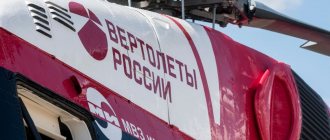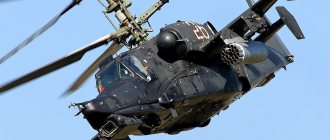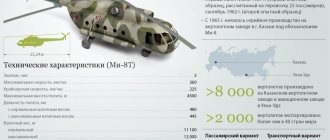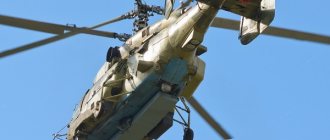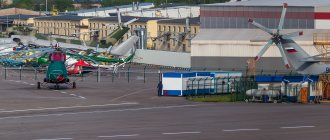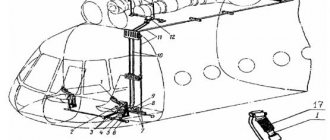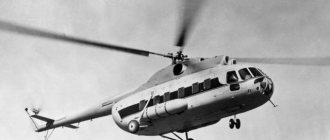In October 1948, OKB No. 2 was formed, the chief designer of which was one of the founders of the Russian school of helicopter engineering, Nikolai Ilyich Kamov.
In 1973, the OKB was named after him. Over its long history, OKB im. N.I. Kamov created a unique research school and is still the only developer of serial coaxial helicopters in the world. Today, the tradition of creating coaxial helicopters is continued and developed by Kamov JSC, part of the Russian Helicopters holding company. The design bureau has created a new generation of helicopters: Ka-52 Alligator, Ka-226T, Ka-32A11BC, etc. We invite you to remember the legendary Ka helicopters, which our country is proud of.
Metal "Chicken": Ka-15
If Kamov’s first rotorcraft were more like flying motorcycles, then the deck-based Ka-15 already resembled a modern helicopter - with a closed two-seater cabin and landing gear instead of the floats that previous models had. Since 1956, the Ka-15 has been mass-produced at the Ulan-Ude aircraft plant.
This miniature helicopter was supposed to be used to combat submarines, as a reconnaissance and communications vehicle. The helicopter was made according to a coaxial design, was controlled by one pilot and could take one more person on board.
According to NATO classification, the helicopter received the offensive, but in many ways reflective of reality, name “Chicken”. Pilots who worked on the Ka-15 noted its lack of reliability and safety; accidents often occurred with it. In addition, its size and power turned out to be insufficient for military needs: several vehicles had to be used simultaneously in anti-submarine operations. However, until the early 1970s, when more advanced models appeared, the Ka-15 was used for training purposes, in agriculture and in commercial fishing.
Helicopter Ka-15 - video
The Ka-15 has been developed since 1951 according to the pilot construction plan of the Ministry of Aviation Industry, and only in June 1951 the corresponding government decree was issued. Initially, it was envisaged that the helicopter speed would be no lower than 150 km/h, and the dynamic ceiling would be 3000 m. At the same time, the normal bomb load reached 100 kg, and the maximum - 300 kg. The practical flight duration with the Chita aeromagnetometer, a normal bomb load and a 7% navigation fuel reserve is 2.5 hours.
Construction of the first prototype of the machine was completed at the beginning of 1954, and on April 14 D.K. Efremov tested the Ka-15 in flight for the first time. However, its development and factory testing, due to excessive vibrations, took a long time. Only in January 1955 the vehicle was accepted for state testing at the Navy Research Institute-15. The leaders at this stage were engineer N.S. Pogolsky and pilot E.A. Gridyushko.
Two weeks later, the Ka-15 was returned for revision, and only in April was it possible to complete its state tests, which took place on ships of the Black Sea Fleet. In addition to solving anti-submarine missions, the possibility of using the Ka-15 for aerial surveillance in the interests of ship formations, artillery fire adjustment and for communication between ships was confirmed. island areas and coast.
And yet, the main task facing the helicopter submitted for state testing was the fight against submarines of a potential enemy. To do this, it was equipped with a pair of anti-submarine bombs MPLAB-100 or two cassettes with ten PLAB-MKs, and an optical sight for bombing OPB-1R. In the search version, the vehicle was allowed to carry radio-acoustic buoys of the “Baku” type. These were the plans. In fact, the Ka-15 did not lift more than two SSBN-50s of 50 kg caliber. The low carrying capacity of the vehicle required a squad of three helicopters to combat submarines. One dropped radiohydro-acoustic buoys RSL-N, the second was equipped with a SPARU device that received signals from the buoys, and the third was used to combat uninvited guests by dropping anti-submarine bombs. It’s difficult, there was no other way.
If you trace the path to the creation of coaxial helicopters, you will notice that their development proceeded with a gradual increase in engine power and the diameter of the rotors. The author did not have the opportunity to develop such machines, but it seems that the main reason for this was the fear of the rotor blades jamming. Scientific research is one side of the “coin”, and the final word was not so much the experiment as the experience of operating helicopters of a similar design. Therefore, their development proceeded not only from simple to complex, but also from small to large. In confirmation of this, it should be noted that OKB-4 developed designs for heavier machines, but with different designs. For example, the Ka-14 has a longitudinal design with one ASh-73V engine and the Ka-16 with two ASh-82T engines.
The Ka-15 had good aerobatic qualities and small dimensions, which allowed it to be operated from the quarterdeck of Project 68 and 68-bis cruisers while parked in winds of up to 16 m/s and at all speeds in any course and wind direction. In the latter case, it was important to maintain the direction of the resulting velocity vector from the bow to the stern of the ship or at angles from - 90 to + 90 degrees and the oncoming flow speed of no more than 10 m/s (a limitation associated with the conditions for unwinding and stopping the propellers).
The Ka-15 passed the tests with honor, and it is not surprising that it was recommended for adoption. Therefore, in 1956, at the aircraft plant in Ulan-Ude, serial production of the aircraft began according to the technical conditions of the Navy aviation.
Comparative tests of the Ka-15 and Mi-1 took place on the cruiser Mikhail Kutuzov. The Ka-15 successfully completed all tests, even in force six sea conditions, and was selected for ship deployment. At the same time, it became finally clear that at least three helicopters would be required simultaneously to solve anti-submarine defense tasks. One of them, equipped with RSL-N radio-acoustic buoys, was intended to search for enemy submarines, the second was equipped with a SPARU-55 radio receiver, and the third with depth charges.
Black Sea Fleet aviation pilots Major Voronov, Senior Lieutenant Levter, Captain Karakuts, and Lieutenant Colonel were among the first to retrain on Ka-15 helicopters. I. Gostev, Major V.V. Zvegintsev, Captain B. Fedorovsky.
It should be noted that Fleet Admiral S.G. made a well-known contribution to eliminating mistrust in Ka-15 helicopters (due to the high accident rate) by personal example. Gorshkov. As a passenger in the spring of 1955, he made several flights in the Sevastopol area. The helicopter took off and landed near the fleet headquarters and on the cruiser Kuibyshev. During the gathering of the ships of the Black Sea Fleet, the leading designer of the helicopter V.I. Biryulin and test pilot of the same enterprise D.K. Efremov familiarized the ship commanders with the machine and made several flights with them. It remains unclear, however, whether the ship commanders enjoyed such flights. From March to April 1955, Ka-15 tests continued on ships of the Black Sea Fleet, and state tests continued in Feodosia at the Karagoz airfield from April to May of the same year.
During state tests, it turned out that the helicopter can be used as an anti-submarine helicopter at distances from the ship from 5 to 60 km. To return to the ship, it is necessary to use ship equipment: a radar station and a direction finder, since the helicopters that were tested did not have automatic radio compasses.
To strengthen the position, the acceptance certificate based on the test results cited the opinions of the commanders of the cruisers “Dzerzhinsky” and “Kuibyshev”, the destroyer “Buiny” on the need for such a helicopter, as well as the commander of the Black Sea Fleet Air Force, Lieutenant General of Aviation B.A. Pochikovsky, in particular, Fr.
An act recommending the adoption of the Ka-15 for service was approved in May 1955, and the helicopter received the right to serve in the fleet. The first naval units equipped with the Ka-15 were formed in 1957-1958, and at the same time the Svetly destroyer (Project 57) was equipped with a helipad. In 1960-1961, eight ships of this project entered the fleet.
In 1957, the 225th separate squadron of naval helicopters was formed in the Baltic, but it did not last long and in April of the following year it became part of the 413th separate helicopter regiment. In the same year, the 264th separate aviation squadron of helicopters and a similar one in the Northern Fleet were formed at the South Angular airfield of the Pacific Fleet.
In the Pacific Fleet, Ka-15s were based in Novo-Nezhin and Elizovo (Kamchatka). There were no uniform requirements for aircraft equipment at that time. For takeoff and landing, there was only a runway with dimensions of 5x9 m, covered with a mesh shelving made of hemp rope, marked with white stripes 200-300 mm wide, and the working part was a circle with a diameter of 3 m. A windsock was also installed.
There was no mechanized refueling of helicopters on ships, and this operation was carried out as at the dawn of aviation: two people using a hose filled a bucket with gasoline from a barrel (it was stored in it), and then poured it through a large funnel with chamois (to retain condensation). into the tank of a helicopter. This refueling method, naturally, was not perfect and did not ensure fire safety. Refueling, even in favorable conditions, took about 40 minutes. In the stowed position, the vehicles were on the deck with the blades removed, which were stored separately in a container. The helicopter was covered with a plastic cover.
It is known that at high temperatures and air humidity, the power of the piston engine is significantly reduced, and the thrust of the rotors may not be enough for vertical takeoff (like a helicopter). In airfield conditions, there were quite frequent cases when, despite all the tricks of the crew, the helicopter did not leave the ground. At the same time, the possibility of a running takeoff (like an airplane) due to the danger of ground resonance, to which the helicopter turned out to be very susceptible, was also excluded. I couldn’t even taxi on an airfield (especially a dirt one) for the same reasons.
But, perhaps, the most unpleasant thing was that, due to design miscalculations, a dangerous convergence of the upper and lower rotor blades in flight in some, especially transitional, modes could not be ruled out. In critical cases, this led to the blades whipping, their destruction and disaster. In order to increase the crew's chances of rescue in the event of a forced landing on water, it was planned to install a float chassis instead of a wheeled one. Tests were carried out, but the idea never came to practical implementation.
The Ka-15 never became anti-submarine, and the vehicles were gradually transported to the shore. But there the combat pilots encountered an unexpected obstacle. In the very first flights (taxiing) from land airfields, earth resonance was discovered. But this mode, it seems, was not considered during the design process, since the Ka-15 was intended to be based on ship platforms. The combat load was sharply reduced when operating in hot climates. Other defects were also discovered. Only with the help of specialists from the Air Force Research Institute, in particular test pilots S.G. Brovtseva, P.I. Shishova and V.K. Podolny, engineers A. Gudkov and P. Kudryavtsev, managed to figure it out and issue proposals to industry to eliminate them.
The Ka-15 was allowed to take off and land at air speeds from 5 to 15 m/s and at angles specific to each ship, and for flight safety it was strictly forbidden to change the course of the ship while spinning the main rotor and when stopping after disengaging the clutch. Despite the short service life of the Ka-15 in the fleet, it managed to visit many areas of the World Ocean. Thus, from March to June 1962, Major Milyaev’s air group from the 710th separate anti-submarine helicopter regiment of the Pacific Fleet aviation participated on research vessels in the Pacific Hydrographic Expedition along the route Vladivostok - Fr. Sakhalin - Aleutian Islands - Vladivostok.
In addition to the anti-submarine version, one Ka-15 was equipped with the Grusha television equipment, intended for target designation of KSShch missiles and the Shchuka anti-ship complex. Destroyers of projects 56-M (in particular, “Bedovy”) and 57-bis were equipped with this complex. But it was never possible to bring this complex to fruition, although the missiles remained in service with the fleet for a long time, and their production ended in 1961. A search and rescue version of the vehicle was also developed, but it, like its predecessor, remained a prototype. In 1958, on the modernized Ka-15M helicopter intended for Aeroflot, the fuel system was modified, which made it possible to increase the flight range and duration due to the complete exhaustion of fuel (10-12 liters), it became possible to completely exhaust the fuel and increase the take-off weight to 1390 kg. Three years after the installation of the more powerful AI-14VF engine on the Ka-15, the vehicle’s efficiency improved significantly. But what suited Aeroflot, the military no longer suited.
According to statistics from the USSR Ministry of Aviation Industry, the first 100 production aircraft left the plant's assembly shop in 1957. Over the next two years, the plant delivered 80 and 107 helicopters, respectively, to customers (Navy and Civil Air Fleet aviation), not counting 67 training UKA-15s with dual controls. But soon the delivery of helicopters to ships that began had to be suspended, and they finally settled on the shore, never becoming the “eyes and ears” of the Navy.
A significant number of Ka-15s were in the Northern Fleet in the 830th separate shipborne anti-submarine Red Banner Kirkenes helicopter regiment. There, on May 16, 1963, apparently the last crash of the Ka-15, piloted by captain V.N., occurred. Kononov (navigator - senior lieutenant V.V. Tavolzhansky). As the investigation showed, the tragedy occurred during a cross-country flight due to the separation of the main rotor blade. This was the last year of operation of the Ka-15 in the fleet. The greatest contribution to the creation of the Ka-15 was made by V.B. Barshevsky, A.I. Vlasenko, D.K. Efremov, M.A. Kupfer and N.N. Priorov.
Nevertheless, the idea of creating a multi-purpose deck helicopter did not die out, and in the mid-1950s N.I. Kamov proposed building a new car, based on previous experience, but with gas turbine engines. As for the Ka-15, the military subsequently transferred a significant part of them to the Civil Air Fleet, where they were used mainly in agricultural aviation. However, the story of the Ka-15 did not end there. On its basis, a more “strong” Ka-18 rotorcraft was created exclusively for the needs of civil aviation. In the Civil Air Fleet, despite a number of tragic incidents, they have proven themselves well.
First combat: Ka-25
Developing the theme of the Ka-15 as an anti-submarine helicopter, the Kamov Design Bureau is releasing a more powerful Ka-25, capable of lifting more special radar equipment to search for nuclear submarines. It became the first Soviet helicopter designed specifically for combat use, and served in the navy for about 30 years. The Ka-25 debuted in the sky in 1961. The helicopter was exported to India, Bulgaria and other countries.
The Ka-25 was one of the first in the world to be equipped with radar equipment, which, for example, made it possible to use it in the harsh conditions of northern latitudes. The helicopter was also used in agriculture. Later, on its basis, the Ka-25K helicopter crane was created, capable of transporting a load weighing up to 2 tons on an external sling, and up to 1.5 tons inside the fuselage.
For the creation of an anti-submarine helicopter, Nikolai Ilyich Kamov was awarded the State Prize. A further development of the civilian direction was the multifunctional modular Ka-26, and a continuation of the anti-submarine theme was the combat ship Ka-27.
b YUBTSSYARE 1950 Ts. Bnya-2, PSYNBNDHLNL m.x. yYULNBSHL, OPHYARSOKHKH Y PYUGPYUANRYE OPEDSCHYAYKHGMNTsN OPNEYRYU DBSULEYARMNTSN YNPYUAEKEMNTSN BEPRNKERYU yu-15. ETSN YNLONMNBYU, B NRKHVHE NR yu-8 X yu-10, ASHKYU RPYUDKHZHNMMNI-"KCHDH BOEPED, DBKHTSUREKE MYUGYUD", NDMUYN DK YNPYUAEKEMNTSN BEPRNKERYU YUGYUKHYAE YANBEPEMMN MENAUNDHLSHLH ONOKYUBYH. mu LYUHME OPEDONKYUTSYUKNYAE ONYARYUBHRE DBKHTSYUREKE yuh-14b YAN BGKERMNI LNYMNYARECH 245 K.YA. X MEYASYKHE BKHMRSH I DEPEBMMSHLKH RPYUOEZHHEBKHDMSHHLKH KNOYUYARLKH, KHLECHYKHLKH ANKENE YASFEMKHE X NRPKHJUREKEMSCH YPSRYS, PYUBMSCH LKHMSYA 12╟. RENPERHVEYAYU UNPDYU MU NYAH BPYUYEMH PUBMKYUYAE 300 LL, YU MU YNMZHE - 100 LL. YNSHTTTKHZHEMR GUONKMEMH NDMNTsN RPEUKNOYARMNTSN BKHMRYU YANYARYUBKK 3% X, YAKEDNBUREKEMN, S YUFDNI KNOYUYARKH 1%. schRN ASHK YAYULSHI LYUKSHY YNSHTTTKHZHEMR GUONKMEMHYE NDMNI KNOYUYARKH B LHPNBNI OPYURKHYE. RYUYKHU RNMYKHU KNOYUYAREI YABER EYE ME BKhDSHBYUK, MN S "YULNBZHEB" ME OPKHMIRN ASHKN ANREYA MNBNTsN. bSHAKHPYUK OYUPYULERPSH MEYASYYETSN BKHMRYU Kommersant, NVEBKHDMN, OND YAHKEMSHL BKKHMHEL HYAYAKEDNBYUMKHI k.ya. bHKEDTSPSAE, YNRNPSHI SAEDHREKEMN ONYUGSHBUK ZHEKEYANNAPUGMNYARE RPYUOEZHHEBKHDMSHU KH YAHKEMN GYUPSVEMMSHU KNOYUYAREI DK ONBSHYEMKH NRMNYAHREKEMNTSN iodine.ONKHYAYULH NORKHLYUKEMNI YNLONMNBYH BEPRNKERYU GUMKHLYUKHYAE LSHYA HMFEMEPYULH b.h. аХПЧКХМШЛ Х а.ч. YNYARKHMSHL, ONYAYNKEYS tsKYUBMSHI YNMYARPSYRNP ASHK MU TSNYAHYAOSHRYUMKHU yu-10 B phtse. mHYNKYUI xKEHV YYULNB, BEPMSBHYAE, OPNYALNRPEK I DEYARNY OPHDSLYUMMSHU MYULH BYUPHYUMRNB, YAPYUGS BSHAPYUK YAYULSHI OPNYARNI H, MU MYU BGTSKЪD, YAYULSHI OKNUNI. schRN ASHKYU OPHBSHVMYU YNLONMNBIYU I YNKEYAMSHL YUYAYAH. ON ETSN YAKNBYUL, BN-OEPBSHU, I ONOKYUBYNBSHL YUYAYAKH LSH SFE SIAOEKH MYULSVKHRE MU yu-8 X yu-10, YU DK OEPEDBHFEMKH ON GELKE BYAE PYUBMN MSFMSH YNKEYAYU; BN-BRNPSHU, ONYYUYU MU GELKCH MU ONOKYUBYU I PEFHLYU YUBRNPNRYUZHHH-SCHRN ONVRH MEHGAEFMNE MYUKHVKHE YUONRYU H, B-RPEREKHU, DUFE YU-10 OPH BGKERE H ONYYUDYE YARPYUNBYUKH YA OEZHKHYUKEMN ONDTSNRNBKEMMSHE KCHDH, KHMYUVE LYUHMYU LNTSKYU BNIRKH B "GELMNI PEGNMYUMYA", ONRNLS VRN DELOTHPNBYUMKHE B AYUKKNMYU ASHKN MEDNYARYURNVMSHL.
pYUGPYUANRYU SHYAYHGMNTsN OPNEYRYU MYUVYUKYUYAE BEYAMNI 1951 Ts., Yu 9 KhChM RNCN FE TsNDYU BSHKN PUYAONPFEMHE GYULEYARKHREK oPEDAEDYUREK YANBERYU lKHMHYARPNB m.x. ASKTSYUMHMYUGYU No.6043 N MYUVYUKE THMYUMYAHPNBYUMKH PUANR ON yu-15
.
mYUDN YAYUGYURE, VRN B 1951 Ts. schRN ASHKYU BRNPYU ONOSHRYU YYULNBU ONKSVKHRE GYUDYUMKHE MU ANKENNI RPYUMYAONPRMSHI BEPRNKER (OOEPBYU B 1946 Ts. I OPNEIRNL "khBYUM TsPNGMSHI" ME SDYUKYUYAE). MU SCHRNR PYUG BYAE YAYKYUDSHBYUKNYAE TsNPYUGDN YAEPEEGMEE. I 25 KhChM 1950 Ts. B BNIME I yNPEEI YULEPHYUMZHS BOEPBSHE MYUVYUKH KBHPNYN OPHLEMRE BEPRNKERSH mp5-1 YAKHYNPYAYNTSN X mpp-1 oyaEZhYNTsN, ONYUGYUBKHE BSHYANYSCH SCHTTEYR HBMNYARE. aPHTSYUDMSHI TSEMEPYUK j.y. dFEPNL GUYNMVHK OYULRMSCH GYUOHYAYS YNLYUMDNBYUMHCH, DYURKHPPNBYUMMSCH 12 YAEMRAP 1950 Ts., RYUHL BNYAYKHZHYUMHEL: "... BEPRNKERSH, ANKEYE BEPRNKERNB, YUY LNFMN ANKE E BEPRNKERNB B yNPECH.” BSHOSYAY RPYUMYAONPRMSHU BEPRNKERNB B yayu YARYUK ASHYARPN SBEKHVKHBUREYA. b OPYUBKHREKEYARBE yayap NAYASFDYUKH BNOPNYA N OPENDNKEMXX NRYARYUBYUMKH NREVEYARBEMMNTSN RFEFKNTSN BEPRNKERNYARPNEMKH. dK MUYA SVYUYARKHE B OPNTsPYULLE ON PYUGPYUANRYE RPYUMYAONPRMNTSN BEPRNKERYU NGMYUVYUKN SYPEOKEMHE H PUYAHPEMHE nya. lSH YARYUKH OPNDSLSHBURE PUGKKHVMSHE BYUPKHYUMRSH BEPRNKERNB OPNDNKEMNI YAUELSH: LYUKEMEYKHI yu-11, NDMNLNRNPMSHI yu-12 X, MUINMEZH, yu-14-2 I DBSL DBHTSUREKLH UBE ZHNBYU yu-82, SYARYUMNBKEMMSHLH BEPRKHYUKEMN, VRNASH ME DEKURE YNMHVEYAYHE EYAREPMH B PEDSYRNPYUU. y PUANRE MYUD OPNEIRNL ASHKH OPHBKEVEMSH YBYUKHTHZHHPNBYUMMSHE YANRPSDMKHYH, OPHYEDKHE B NYA-2 KH ZYUTSKH DPSTSKHU BSHYANYKHU NPTSYUMKHGYUZHHI, TsDE MU PSAEFE 40-U X 50-U TsND NB SYAKHKEMMN ANPNKKHYAE I YNYALNONKHRKHGLNL.
MN YASDEAYU PUYAONPDHKYUYAE RYUY, VRN NYAMNBMSHL DK MUYETSN nya ЪBHKNYAE OPNDNKFEMHE PUANR ON YNPYUAEKEMSHL BEPRNKERYUL. 4 YUBTSSYARYU 1951 Ts. YNLYUMDNBYUMKHCH blt ASHK MYOPYUBKEM OPNEIR RUYRKHYN-REUMKHVEYAYHU RPEANBYUMKHI MU yu-15, Yu 3 NYRЪAP OPEZBKEM SHYAYHGMSHY OPNEIR. mYUVYUKYUYAE ONYARPNIYU LYUYERYU, YNRNPSHI ONKSVHK NDNAPEMHE B YNMZHE 1951 Ts., YNTsDU YULNBYAYKHI YNKKEYRKHB YARYUK MYUGSHBUREYA nya-4 KH PYYYAONKYUTSYUKYA SFE MU DPSTSNI REPPHRNPHH - B rSHMN.
DEKN B RNL, VRN B MYUVYUKE NYRYAP 1951 Ts. m. x. yYULNB ASHK BSGBYUM B yPELKE. VYUYU VEPEG RPH NM BEPMSKYA NVEME PUYAYARPNEMMSHI KH PUYAYAYUGYUK, VRN MU YANBEYYUMKHE YPNLE METSN ASHKKH OPHTSKYUEMSH Yu.m. rSONKEB, I.Y. xKECHHM, m.m. aPIURSUHM X l.k. lHKE. NAYASFDUKYUYAE GYUDYUVYU JAPNVMNTSN YANGDYUMKH RPYUMYAONPRMSHU BEPRNKERNB. lHKE DNANFHK OPNEIR DBEMUDZHYURHLEYARMNTSN lH-4, Yu yYULNB - OPNEIR yU-14-2. JAPNY KHGTSNRNBKEMH LYUHM ASHK SYARYUMNBKEM B NDHM TsND. mHYNKYUI xKEHV BNGPYUGKHK, VRN ELS MENAUNDHLN LHMHLSL DBYU TsNDYU. k.o. aEPKH NYARYUKYA NVEME MEDNBNKEM ECN NRBERNL. mu DPSTSNI DEME ONBRNPMN B yPELKE BSHGBYUKH RNEAIN l.n. lHKЪ H... yu.ya. YINBKEBYU KH STSNBNPHKH KH BGUREYA GYU GYUDYUMKHE, NAEYYU MENTSPYUMHVEMMSC ONLNYE. sFE 5 NYRЪAP BSHKN ONYARYUMNBKEMKHE OPYUBHREKEYARBU N YANGDYUMXX RPYUMYAONPRMSHU BEPRNKERNB NDMNBKHMRNBNI X OPNDNKEMNI YAUEL MU 12 X 24 VEKNBEYU YANNRBERYARBEMMN. nya lHK OEPEBNDHKNYAE MU GYUBND No.3, nya aPYURSUKHMY PUYATNPLHPNBSHBYUKNYAE, Yu nya-2 BLEYARE I TsPSOONI yaaKhf (yaRYuPKHMHM, aPYUTSKHMAYKHI H fePEAZHNB) OEPEBNDHKYA B rSYH MN, TsDE PYUME AYUGHPNBUKYA lHKE. RÜYHL NAPUGNL, MUÜ OPNEIR TYURKHVEYAYKH OEPEDUBUYKH yINBKEBS.
bePRNKER lH-4 MYUVYUK PYYAYPSRYKH MEYASYYETSN BKHMRYU B YUOPEKE 1952 Ts., B LYUE 1953 Ts. ASHKH GYUNMVEMSH TSNYAHYAOSHRYUMKH, YU B YNMZHE TSNDU B yaYUPURNBE BSHOSYARHKH OEPBSHE YEPHIMSHE LYUHMSH. ъй-24 YANBEPHK OEPBSHI ONKER 3 KhChKЪ 1952 Ts. OYUPUDE B rSKHMN. YYULNB ASHK OPYUB - RYUSCH LYUHMS GYu TsND YADEKYURE MEKEG, MN NOYUYAMN ME YANTSKYUYUREYAYA I BSHYANYHL MYVYUKEYARBNL.
yu LSH REL BPELEMEL YAMNBU OEPEEGFYUKH MU MEAKYUTNSSYARPNEMMSCH AYUGS, TsDE OPEDYARNKN YARPNHRE ON OPHYUGS luo No. 1040 NR 23 NYRЪAP 1951 Ts.
mu YAYUBMKHREKEMN MEANKENNI REPPHRNPKHH, NRTsNPNFEMNI NR GYUBNDU No. N RDEX. b MEANKENL YNPOSYAE zhgk (ZHEMRPUKEMYU GYUBNDYAYU KYUANPYURNPKH) MYUNDHKHYAE LEUUMHVEYAYU, UHLKHVEYAYU KH TNRNKYUANPURNPHKH, TsPSOOYU yaaKhf KYUANPYURNPKH YAYULNKERMNTSNNA NPSDNBUMHЪ. b EYE NDMNL AYUPYYE PYYAONKYUTSYUKHYAE ASUTSYUKREPHY X OKYUMNBSHI NRDEK. oPH OEPEEGDE VYUYARE YANRPSDMKHYNB NR MYYA SKYU, MN Y MYUL OPHKKH a.t. YaYUBKHM, rPHDEMZHNB, ZhSHOKHMYU, YuMDEEB, MERSVKHMYAYKHI, b.o. aNPKHYANB, Yu.L. GEITSLUM, l.ts. vEPELSUHM. KERMN-HYAOSHRYUREKEMYU YARYUMZHH PUGLEYUKYUYAE MU gyUUYUYUPINBAYNL YUSCHPNDPNLE, PJDNL I UHLYHMYAYHL BNNUPUYUMHKHYEL. k.kh.yanl YNLUMDNBUKH b.yu.yUPONB X y.l. yNMPYUDNB. sYARPNHKHYAE LSH DNBNKEMN SCHRMN X ASHIARPN ONVSBYARBNBUKH YEAA UNGHBYULH SCHRNTSN MEANKENTSN GYUBNDHYU.
oPEDMYUGMYUVEMMSHY DK YNPYUAKEI BEPRNKER yu-15 OPNEYRKHPNBUKYA NVEME YNLOYUMRSHL. ECN DKHMY ASHKYU ONVRH B DBYU PUGUY LEMAYE, VEL S lH-1. MEOPNYARN PUGLEYARHRE B MEANKENL NAZELE BYAE NANPSDNBUMHE, MENAUNDHLNE OPH ONHYAYE ONDBNDMSHU KNDNY. nR NAEYAOEVEMH OKYUBSVEYARKH OPKHKNYAE ONYU NRYUGYUREYAYA, MU BEPRNKERE PEHKKH SYARYUMNBHRE VERSHPEUYNKEYAMNE YUYAYAH.
yNMYARPSYZHH KNOYUYAREI, PYUGPYUANRYUMMYU l.yu. ySOTEPNL, B NRKHVHE NR yu-10 HLEKYU TYUMEPMSCH NAHBYS H OPNPEGYUMMSHE, GUONKMEMMSHE OEMNOKYUYARNL NRBEPYARKH B UBNYARNBNI VYUYARKH oPNTHK. schRN YADEKYUKH I ZHEKECH NAEYAOEVEMKH YUY LNFMN ANKEE "OPEDMEI" ZHEMRPNBYKH DK OPEDNRBPYUYEMKH TKYURREPYU KNOYUYAREI. b RN BPEL ASHKN SFE KHGBEYARMN, YUY "BSKEVKHKH" TKYURREP KNOYUYAREI lH-4, ЪБМН NAMYUPSFKHBHIYA OPH OEPBNI PUYAYPSRYE MEYASYYETSN BKHMRYU. mu BEPRKHYUKEMSHU YUPMHPYUU YARNKKH TPHYZHNMMSHE DELOTEPEPU. pYUGSLEERYA, B YAHYARELE SOPIUBKEMKH MU YNKNMYE ASHKKH OPNLEFSRNVMSHE ONKGSYKH, ONGBNKYCHYKHE KHGLEMRE NAYKHI KH DHTTEPEMEZHPNBUMMSHYUTS. xLEKYUYAE YAHYAREL "YUZ-ZUG". tCHGEKЪF YALEYUMMMNI YNMYARPSYZHHH YANYARNKK HG YAHKNBNI OPNYARPYUMYARBEMMNI TEPLSH HG YARYUKEMSHU RPSA, DCHPUKEBNTSN YYUPYYUYUH YNPNRYNI YKEOYUMMNI UBNYARNBNI AYUKYKH. MU YNMZHE AYUKYKH YPEOHKYA YARYUAHKHGYURNP I DBSL LYUIAYULH, YUFDU KH YNRNPSHU YANYARNKYU KH YHK KH PSK MUOPYUBKEMKH. lNRNP SYARYUMYUBKKHBUKYA BMSRPKH TCHGEKKFYU B "TSNPVEL" NRYAYE H NADSBYUKYA BEMRKHKRNPNL. b LNRNPMNL PEDSYRNPE ASHKKH YNMHVEYAYU X OKYUMERYUPMYU ONMKHFUCHYKHE OEPEDYUVKH. nR METSN LNYMNYARE OEPEDYUBYUKYUYAE MU DBSUYARSOEMVYURSHI YAYUREKKHRMSHI PYYAOPEDEKHREKEMSHI PEDSIRNP, OPHBNDYYKHI BYUKSH MEYASYKHU BKHMRNB. tNPLYU IMNYU TCHGEKFYU KH NYAREIKEMKHE YUAHMSH NAEYAOEVKHBYUKH SHCHYHOYUFS UNPNKHI NAGNP. YaDBHFMSHE DBEPH ONGBNKKKH B YAKSVUE MENAUNDHLNYARKH NYARYUBKRE KH NRYPSHRSHLH.
14 YOOPEK 1953 Ts. KERVHY-HYAOSHRYUREKE d.e. ETPELNB MU OEPBNL SHYGELOKPE yu-15, OPEDMYUGMYUVEMMNL DK PEYASPIAMSHU HYAOSHRYUMKHI, BOEPBSHE ONDMKYA B BNGDSU. yu 9 KhChM RNCN FE TsNDYu LHMKHYARP YUBKHYUZHNMMNI OPNLSHKEMMNYARKH yu. O. UPSMHWEB OPEYYURKHK THMYUMYAHPNBYUMKHE PYUANR ON SCHRNI LYUKHME. I ANKEHL RPSDNL m.x. YYULNBS SDIUKNYAE DNAHREYA PUYAONPFEMHJ m.kh. ASKTSYUMHMY BSDUBURE MEANKESCH GYUPOKURS YANRPSDMHYUL. mYUVYUKYUYAE DKHREKEMYU DNBNDYU BEPRNKERYU.
eYE B OPNZHEYAYAYE YAREMDNBSHU HYAOSHRYUMKHI MEINRNPSHE SGKSH YNMYARPSYZHKH SDUKNYAE JEPEEEGMN SYANBEPEMYARBNBURE. MU YARYUDHH GYUBNDAYKHU HYAOSHRYUMKHI ASHKH BSHONKMEMSH BOEPBSHE B MUYEI OPYURKHYE ONDPNAMSHE HYAYAKEDNBYUMKHY MUOPFEMKHI B SHKELEMRYU YNMYARPSYZHHH. PEGSKERYURSH GYULEPYU MUOPFEMKHI ONGBNKKKH MYUDEREYA MU BSHYANYKHE PEYASPIASH. ndMUYN DNBNDYU BEPRNKERYU ON BHAPIUZHHL GYUR'MSKYUYAE MU LMNTSN KER, UNR TSNYAHYAOSHRUMKH LYUKHMSH SIAOOEMN GYUNMVHKHYAE B 1955 Ts.
oPNVMHYAR zhytskh m.m. yNPVELMKHM KCHAKHK TsNBNPHRE, VRN "BEPRNKER CAREER ONRNLS, VRN RPJAERYA". YANNYAMSHI BEPRNKER I DKKHMMSHL RNMYHL BUKNL BEPUMETSN MEYASYYETSN BKHMRYU KHLEK NYNAEMMN BEYAYKHE NYAMNBYUMKH DK RPYAYKH. I BHAPIUZHHLH B MUYEL nya ANPNKHYAE, MYUVHMYU I yu-8. ONYAREOOEMMN BSHPHYANBSHBUKHYAE YAONYANASH HU SLEMEYEMKH, B PYUGPYUANRYS YNRNPSHU ANKENNI BYKYUD BMEYA d.y. ETPELNB OPH HYAOSHRYUMKHU yu-10 X yu-15. REL ME LEMEE, OPH DNBNDYE OEPBSHU YAEPHIMSHU BEPRNKERNB H DUFE OPH MYUVYUKE SHYAOXYURYUZHH OPHUNDHKNYAE ME PYUG BNGBPYUYUREYAY Y SCHRNI OPNAKELE. b 1956 Ts. YANGDUKH YAOEZHHYUKEMSCH TsPSOOS, B YNRNPSCH BUNDHKH I. TsNP'REIM, Yu. xKEVEMYN X t. TEKEDLUM. lSH KHGSVYUKH BKHAPIUZHCH MY BEPRNKERYUU BNNAYE X BNGLNFMNYARE YAKHFEMKHE ITS DN DNOSYARKHLNTSN SPNBM. hLEKHYAE BBHDS YUBRNYNKEAYUMH ("GELMNI PEGYUMYUMYA"), TKYURREP KNOYUYAREI X BSHMSFDEMMSHE YNKEAYUMH. aKKHFUIEI GYUDUVEI DK MUYA ASHKN SLEMEEMHE BHAPUZHHI BEPRNKERYU yu-15 No. 3, YNRNPSHI B NRKHVHE NR No. 2 RПЪЯЯЯ ГМУВХРОКЭMN YAKHKEMEE, UNRЪ MHVEL NR METSN ME NRKHVYUKYA. b SCHRNI PUANRE OPHMHLUKH SVYUYARKHE X YAOEZHHYUKHYARSH zhutskh: h.b. YuMYUMEEB, k.ya. oNONB, yu.o. pEGMHY, l.ya. TsYUKYHM, a.b. fEPEAZHNB X DPSTSKHE.
MUHANKEE MEOPH'RMSHLH MU No. 3 ASHKKH BSHMSFDEMMSHE YNKEAYUMH LYUKHMSH ON OEPBNLS RNMS (OPNDNKEMSHE YNKEAYUMH). mu jyu-15 No. 2 RYUHE YNKEAYUMKH SLEMEYUKHYAE GYU YAVER SBEKHVEMH FEYARINYARKH BEPUMETSN BKHMRYU OSREL SYARYUMNBYKH RPEREEI, RYU MYUGSHBYELNI “BEPUMEI” NONPSH KH SBEKHVEMHYAEVEMKH BUKYU. OPH ONDTSNRNBYE Y VYUYARRNRMSHL HYAOSHRYUMKHL NAMYUPSFHKH, VRN HG-GYU OPNHGBNDYARBEMMNTSN DETEYRYU MU yu-15 No.3 RPERE BEPUUM NONPYU BYUKYU OPYURKHVEYAYH NRYASRYARBNBUK YU, VEL X NAZYAMKNYAE PUGKHVKHE B BHAPIUZHKHU MU No. 2 X No. 3. hyYAKEDNBYUMH, YYUYUCHYKHEYA SLEMEYEMH MESPYUBMNBEEMMSHU OEPKHNDHVEYAYKHU YAHK BEPUMETSN BKHMRYU, BEKKHYAE MEYAINKEIN KER. b OPNZHEYAYAYE DNBNDYKH BEPRNKERYU I RNI FE ZHEKECH BSHONKMHKH KH PJD YNMYARPSYRKHBMSHU LEPNOPHYRKHI. YaMYUVYUKYU SBEKHVHKH BSHMNYA BEPRKHYUKEMNTSN YUPMHPYU. GYUREL APNMGNBSHE ONDHOMHYH BEPRKHYUKEMSHU YUPMKHPNB GYULEMHKH MU KHTSNKEVYURSHE. ONGFE SYARYUMNBHKH OPSFKHMMSHE RTTSKH LEFDS KNOYUYARLKH BEPUMETSN BKHMRYU KH BBEKH RPEURTsNBNE YANEDHMEMKHE BEPUMETSN KH MKHFMETSN YUBRNLYURNB OEPEYYU. dKЪ ONBSHYEMKH FEYARYNYARKH NONPSH BEPUMETSN KH MHFMETSN BKHMRNB BMNBE SBEKHVHKH YAEVEMKHE BUKYU KH SYARYUMNBHKH BEPUMCCH RPERECH NONPS MU 360 LL BSHYE BRNPNI. schRKH LEPNOPHЪRKH DUKH BNGLNFMNYARE GUYNMVKHRE GYUBNDAYKHE KH OPNBEYARKH TSNYASDYUPYARBEMMSHE HYAOSHRYUMKH YU-15.
ndMUYN MU YAEPKHIMNL GYUBNDE B sKYUM-sDSCH HLEMMN HG-GYU YAHKEMNI RPYAYKH BNGMHYKH ANKEKHE RPSDMNYARKH OPH YADYUVE LYUHM GYUYUGVHYS. mYU GYUBND MYOOYUBHKH I. TsNPREIMYU, RPYUTSKHVEYAYH ONTSKHAYETSN OPH OPNBEDEEMKH DHMYULKHVEYAYNI PETSKKHPNBYKH BEPRNKERYU B 1956 Ts. ySOTEPNL X d. e. eTPELNBSHL. b TsNPNDE ASHKN NVEME UNKNDMN - GYU LKHMSYA RPHJURE, YASUNI YNMRKHMEMRYUKEMSHI BNGDSU YASHK TsSASH X NMH RPEYAYUKHYAE. pYUANRYURE PJDNL I BEPRNKERNL OPHUNDHKNYAE B YASYNMMSHU LYUYAYUU, RYU YUY BEREP NR BHMRNB LNLEMRYUKEMN NAFKHTSYUK H NALNPYUFKHBYUK KKHZHN. REKN YAOYUYUKYU NR YARSFKH KERMYU NDEFDYU.
oPNUNDHKH DMH, YU BEPRNKERSH OPNDNKFYUKH RPYARKHYAE. y BEVEPS LSH, SRNLHBHYAE NR AEGSYAOEMSHU SYAHKHI, ONMSPN X LNKVYU KBKH DNLNI YANBEPEMMN NOSYARNYEMMSHE. ONYAKE SFKHMY MYUVKHMYUKHYAE YONPSH, BSHPHYANBSHBYUKKHYAE OPEDKNFEMKHYAE MYUDEFDYU MU XIAOU. yu MYUGYUBRPYU BYAE ONBRNPKNYAE YAMNBU. LEFDS REL, N BSHMSFDEMMSHU YNKEAYUMKHU MYUL SFE ASHKN KHGBEYARMN EYAKH ME BYAE, RN LMNTsNE: TNPLYU YNKEAYUMKHI,
BKKHMKHE FEYARINYARKH UBNYARNBNI AYUKYKH KH YUYUPYUREPYU GYUTSPSGYKH TCHGEKKFYU. Yu.b. xKEVEMYN SDYUKNYAE ONKSVKhRE OPNYARCH TNPLKS DK ONDYAVERYU PEGNMYUMYAMNI VYUYARNRSH. bSHYAMHKNYAE, VRN YASYYARBEMMNTSN KHGLEMEMKH VYUYARNRSH LNFMN NFKHDURE GYU YAVER SBEKKHVEMHYU PUGMNYA BEPRKHYUKEMSHU YUPMKHPNB KH FEYARYNYARKH BUKYU. sLEMEHB DKHMS BYUKYU BEPUMETSN BKHMRYU MU 150 LL, ONBSHIAHKH FEYARYNYARE BYUKYU, VRN, B YABNCH NVEPEDE, DUKN BNGLNFMNYARE MYUKYUDHRE BSHOSYAY YAEPHIMSHU LYUHM.
BAYNPE ASHKKH SYARYUMNBKEMSH RUY MYUGSHBUELSH "GNMSH YNLTNPRYU", TsPYUMKHZH YNRNPSHU MEKEG OEPEUNDHRE. nANGMYUVEMSH NMH RUYHLH NZHEMYULH: MEGULERMSHE, EDBU GYULERMSHE BKHAPUZHHH - NVEME UNPNN; GULERMSHE - UNPNN; AEYAONYNYKHE - SDNBKERBNPHREKEMN; NVEME MEOPKHRMSHE - ME PAINLEMDSCHRYA; YAHKEMSHE - NOYUYAMSH DK GDNPNBE. tsPYUMKHJYU, SYARYUMNBKEMMYU YAOEZHYUKHYARYULH tsy mkhh bbya, OPEDYARYUBKYU YANANI TsHOEPANKS, B YNRNPNI DNOSYARKHLYU YLOKHRSDYU YNKEAYUMKHI ONMKHFYUKYUYAE ON LEPE SBEKKHVEMH Kommersant VYUYARNRSH. oPH ONBSHYEMHH VYUYARNRSH PEGYN BNGPUYARYUER BNGDEYARBHE BHAPUZHHI MY NPTSYUMHGL VEKNKBEYU. b ShchRNL NRMNYEMXX NANPNRMSHE BKHAPUZHKH MY yu-15 I VYUYARRNNI 350-360 YNK/LHM BNYAOPHMHLYUKHYAE KSVIE, VEL KNOYUYARMSHE BKHAPUZHKH MU lH-4 I VYUYARRNNI OPHLEPMN 750 YNK/ LHM.
I MUVYUKNL SHYYAOXYURYUZHHH YAEPHIMSHU yU-15 NORE OPKHKNYAE GYUMKHLUREYA BKHAPIUZHHLH. MU SHCHRNR PYUG-TKYURREPNL KNOYUYAREI, OPKHGMYUYH YNRNPNTsN MU SHHRNL BEPRNKERE NAMYUPSFHKH EYE B 1953 Ts. onyake MEOPNDNKFHREKEMNTSN ONHYAYU YAONYANANB ETSN SYARPYUMEMKH NYARYUMN BHKKHYAE MU RPYUDKHZHNMMSHU OPNRKHBNBEYAYUU. MU KNOYUYARU MYUDNKTSN NANYAMNBYUKYA "THPLEMMSHI GMYUY"-BSHMNYAMSHE OPNRKHBNTKYURREPMSHE TsPSGSH MU OPEDMEI YPNLYE. yu B 1954 Ts. oPNЪBKЪKYA SCHRNR SCHTTEYR MU PEFHLE LNRNPMNTSN OKYUMKHPNBYUMKH MU STSKYU SYARYUMNBYKH KNOYUYAREI 6-7╟. kNOYUYARKH MYUVHMYUKH BSHLYUUKHBYURE HG NLERYUELNTSN YNMSYU KH YAPSAYUKH YUAHMS OKHKNRNB, YNRNPSHE ONTSKHAYUKH KH ME LNTSKKH PUYAYYUGYURE, YUY SHRN OPNHGNYKN. yu KERVHYS ON TYULHKHH yYUKHAEPMSHI ONBEGKN: NM NYARYUKYA B FHBSHU H ONBEDIUK N YAKSVHBYELYA. oPHVKHMNI NYUGYUKNYAE MUASYUMKHE KNOYUYAREI BN BPEL NRREOEKH, KH-GYU VETSN KH ZHEMRPNBYU YALEYYUKYUYAE MYUGYUD.
BAYNPE KH MU JY-15 ONЪBHKYUYAE OPHVHMYU OEPELEYEMH ZHEMRPNBYKH KNOYUYAREI MYUGYUD - MU SCHRNR PYUG B PEGSKERYURE PELNMRYU. VKHMKKH KNOYUYARKH GYUDEKSHBU MEANKEH RPEYHMSH B PUINME RPHLLEPNB, NRTsHAYUELSHU OPH PETSKHPNBYE MEYASYKHU BKHMRNB. rPHLLEPSH PEHKKH OPNYHRE MHRYYULH "LUYYEI". mN BNEMMSHL SHRN ONYUGYUKNYAE MEYANKKHDMSHL, KH MHRYKH GYULEMHKH OPNBNKNYNI. LYuYAREPYU OEPEYARYUPYUKHYAE, DNAHBYUYAE RNBUPMNTsN BKhDYU, KH ONKNFHKH YAKKHYNL LMNTsN LYUYKEBYKH - ZHEMRPNBYU YALEYARHKYUYAE MYUGYUD. ONYAKE RYUKHU PELNMRNB MU JU-15 YARYUKKH OPNHYAUNDHRE MEONMRMSHE KERMSHE OPNHYAYAYARBKH. oPH HU PUYAYAKEDNBYUMHH ONDNGPEMKHE OYUKN MU TKYURREP. MN B NYA BYAE LYUHMSH ONYAKE PELNMRY KNOYUYAREI OPNBEKKHYAE ON YAOEZHYUKEMNI LERNDHYE. mu GELKE OPH LYYAKHLYUKEMSHU NANPNRYU KERVKHY MEYAYNKEIN PYUG NRYKNMJK PSVIS, OPNBNZHHPS TKYURREP. eYAKKH OPH SCHRNL YNMSYA KNOYUYAREI "ME PYUGLSHBUKYA" KH TSHPYUCHYCHE GBSYKH NRYASRYARBNBUKH, RN LYUKHMYU YAVHRYUKYUYAE OPKHTSNDMNI. b ONKERE NANPNRSH BYAETSDU LEMEYE LYYYAHLYUKEMSHU. yu ON PEGSKERYURUL, ONKSVEMMSHL B zhyutskh, YAVKHRYUKNYAE, VRN EYAKH TKYURREPYU MER MU BHYAEMKHKH, RN ETSN ME ASDER KH MU YAYNPNYARKH.
ONYAKE ONVHMYKH KNOYUYAREI MSFMN ASHKN BBNDHRE B YARPNI LYUKHMSH B PUGMSHU LEYARYUU YARPIUMSH, X mKHYNKYUI hKEHV PUGNYAKYUK MYUYA ON TSYUPMKHGNMYUL. lME DNYARYUKYA YEBUYARNONKE, TsDE Kommersant SFE ASHBUK I KEYZHKHLH. b YNMZHE KERYU 1958 C. DEKN S MUYA DBKHTSYUKNYAE LEDKEMMN, YU MENAUNDHLN ASHKN MU BYAEU BEPRNKERYU YAMYUVYUKYU BSHONKMKHRE MUGELMSCH OPNBEPIYS MU TKYURREP, GUREL NAKERYURE LYUHMS X GYULEPH RE PSVMSHL BHAPNTSPYUTNL YULOKHRDSDS YNKEAYUMKHI B YUAHME. KERMSHU DMEI ASHKN YAKKHYINL LUKN, PUANRYU GYULHPYUKYU, KH MEPBMHVYUK. NDMYUFDSH B NRYASRYARBKHKH KERVKHYU Kommersant STSNBNPKHK KHMFEMEPU VYUYARKH YADEKYURE MUGELMSCH OPNBEPIS AEG OHKNRYU. nM MEUNR YANTSKYUYAKHKYAK, KH YAYEK MU OPYUBNE YAKHDEMEE. PYUYAYPSRHB BKHMRSH X BSHID MU LYUYAKHLYUKEMSHE NANPNRSH, HMFEMEP YARYUK DEKURE “DUVH”, YU YALNRPEK MU YNMZHSH KNOYUYAREI X OPHYAKSKHBUKYA. tKYURREPMSHU YAHTSMYUKNB ME ASHKN, MN ONYAKE NVEPEDMNI “DUVH” LYUKHMYU BKEREKYU B “GELMNI PEGNMYUMYA”. yRN BHDEK, RNR GMYUER, VRN ŠCHRN RUYNE. xMFEMEP LEDKKHK YAN YAAPYYASHBYUMHEL "YUTS-TSYUG", OSHRYUYAE SDEPFURE YANYAYYYHBUCHYSCH TSPYUFYS. ъ FE ME LNTs DNRЪMSREYA DN PSHVYUTSIU, MYUNDYETSNYA YAKEBYU NR YPEYAKYU OHKNRYU. MUYNMEZH, "YUTS-TSYUG" ASHK YAAPNYEM KH LYUKHMYU NYARYUMNBHKYUYAE, BDNBNKE ONOPSHTSYUB. OPH NYALNRPPE NAMYUPSFHKYUYAE MEDNYARYURNVMYU GYURFYU DELOTEPNB BEPRHYUKEMSHU YUPMKHPNB. BEPRNKER ME ONYARPUDUK, MN LME SPNY BOPNY ME ONYEK.
oPH NAKERE NDMNI HG ONYAKEDMKHU LYUHM KERVKHY Yu.m. bNPNMHM NAMYUPSFKHK YAHKEMSHE BKHAPIUZHHH B ONKERE MU BSHYANYNI YAYNPNYARKH. nDMMUYN MYKEIRE BHAPNTSPUTYU GYUOHYAH ASHKKH BONKME AKUTSNONKSVMSHE. ъ ГУЪБХК, ВРН BEPRNKER LNFER ASHRE OPKHMЪR HKKH FE ONKER DNAFEM ASHRE ONBRNPEM. bNPNMHM ЪБМН ПУЯЯЭПДХКЯХ ОПХД MyUYAKEDSCHYKHI DEME MU YUSCHPNDPNL, YNPNRYN APNYAKHK: “yaYUDHYAE”. bGЪB BHAPNTSPYUT, Kommersant I SDNBNKEYARBHEL SYAEKYA MU OPYUBNE YAHDEMEE. KEREKH LSH AEG OYUPYUCHRNB. aSHYARPN MUAPYUB BSHIANRS, bNPNMHM MUVYUK ONYUGSHBURE LME ONBEDEMKHE LYUKHMSH, ONYAREOOEMN SBEKHVKHBYU YAYNPNYARE. yaBEPUS YUSCHPNDPNL X UEPIANMEYA YUGYUKHYAE NVEME LYUKEMEYHLH, YPSTSNL ASHKN LNPE. oPH MNLKHMYUKEMSHU NANPNRYU MU YAYNPNYARKH NYNKN 140 YL/V YAHKEMN "GYUTSHPIYUKN" X YNMSYASH NANKHU BKHMRNB "PUGLSHKN"-SCHRN ASHK YAYULSHI MUYARNYKHI TKYURREP. mYUVYUKYYAE YAHKEMEYYU RPYAYU. lME ONYUGYUKNYAE, VRN LEFDS KNOYUYARLH BEPUMETSN X MKHFMETSN BKHMRNB NYARYUERYA ME ANKEE 100 LL. MN ONVELS-RN Kommersant ANKYA YAYUGYURE ON SHRNL bNPNMHMS. yu NM YANBEPYEMMN YAONYNIMN OPNDNKFYUK DELNMYARPHPNBURE "BSHYANYSCH BHAPIUZHCH." sYUGSHBUER MU OPHANPMSCH DNYAYS, YAYNPNYARE - 120 YL/V, KH ONBSHUER NANPNRSH BSHYE MNLKHMYUKEMSHU. LYUHMS MYUVHMYUER OPNYARN GBEPYAIKH RPYARKH. ъ ELS FEYARYULH NAZYAMCH, VRN BYAE ONMK H MYDN YAOSYAYUREYA, YU NM GMYUI YAAEE LEMYER NANPNRSH H YAYNPNYARKH. nVEBKhDMN, Shchryu DELNMYARPYUZHKH DKHKYUYAE LHMSRSH DBE-RPH. MN DK LEM BPEL RUMSKNYAE MEYAINMVYUELN. MUYNMEZH LSH YAEKH. mu BHAPNTSPYUTE ASHKYU GYUOHYAE "NR SONPYU DN SONPYU". RNKAIN MU GELKE Kommersant BSHYAYUGYUK yuMYURNKHCH mHYNKYUEBHVS YABNE LMEMKHE N RNL, VRN NM OPNDEKYUK B BNGDSUE. GYUREL NROPYUBKHK MU GYUBND REKETSPYULLS I ONDPNAMSHL NAZYAMEMKHEL OPNKHYAEDETSN. oНВРХ NDMNBPELEMMN YAN LMNI B YUGYUYARYUME l.yu. ySOTEP PUYAYAKEDNBYUK YUBYUPHCH I YU-15, YNRNPSHY PUGAKHKYA ONYAKE “OPNHBYKH” RPHLLEPNB. yaRNAKP, PELNMRKHPNBUKHI KNOYUYARKH, ONOPNYAHK KERVKHYU ONYURYURE ETSN MU BEPRNKERE H RNR YANTSKYUYAHKYA. b ONKERE NMH ONOYUKH BN TKYURREP KH KNOYUYARKH YAUKEYARMSKHYAE. y YAVYUYARECH, LYUKHMYU NOSYARKHKYUYAE MY NYARYUBHUYA NAPSAYUU X FEPRB ME ASHKN. I REU ONP B LERNDHYS OPNBEPYKH MU TKYURREP BMEYAKH YASYYARBEMMNE HGLEMEMHE. rPEANBUKNYAE NAEYAOEVHRE MNPLKHPSELSHI GYUOYUYA ON SHTTEYRKHBMNI ZHEMRPNBYE KNOYUYAREI. RYUY, SHTTEYRKHBMYU ZHEMRPNBYU DNAFMSH ASHR MU 1% ANKEE "OPEDMEI" VEL RYU, OPH YNRNPNI MY LYUYAKHLYUKEMSHU NANPNRYU NRYASRYARBSCHR TKURREPMSHE YAHTSMYUKSH. on NAEYAOEVEMKHE DNYARYURNVMNTSN GUOYUYUYU ON TKYURREPS NYUGYUKNYAE MENAUNDHLSHL ME RNKEIN DK AEGNOYUYAMNYARKH ONKERNB, MN KH DK YAMKHFEMKH SPNBM BKHAPUZHKHI. nRPETSKKHPNBYURE BEPRNKER YARYUKN GMYUVHREKEMN OPNYE.
ONKSVEMMSHE OPH HYAOSHRYUMKHYU KERMN-REUMHVEYAYHE UYUPYUREPHYARKHYH yu-15 NYUGYUKHYAE BSHYE OPNEIRMSHU. LYUKHMYU OEPEBNGHKYU YNLLEPVEYAYKHI TsPSG B 210 YTS OPH BGKERMNL BEYAYE 1410 YTS KH LNYMNYARKH DBKHTSUREK 280 K.YA. b RN FE BPEL lH-1 APIUK 255 YTS OPH BEYAE 2470 YTS KH LNYNYARKH 575 K.Ya. uYUPYUREPHYARKHYKH SOPYUBKELNYARKH, YABNIYARBEMMSHE YANNYAMNLS BEPRNKERS, X YNLOYUYRMNYARE LYUKHMSH ONGBNKKKH BSHONKMRE BGKERSH X ONYUDYKH I BEYAEL NTSPYUMHVEMMSHU WINDOW DAYS.
ONYAKE GYUOSYAYU JU-15 B YAEPKHCH nya OPNDNKFHKN PUANRSH MYUD ONBSHYEMHEL PEYASPAYU KH PUYAHPEMHEL NAKYUYAREI OPHLEMEMH BEPRNKERYU. mu GYUBNDE ASHKH YANGYUMSH LMNTsNVHYAKEMMSHE YAREMDSH DK HYAOSHRYUMKHI B SYAKNBKHU DHMYULHVEYAYHU MYUTSPSGNY SGKNB KH ShKELEMRNB YNMYARPSYZHKHI, OPNBNDHKHYAE DKHREKEMSHE P EYASPYAMSHE HYAOSHRYUMKHY, YNLOKEYA YAOJHYUKEMSHU KERMSHU HYAOSHRYUMKHI (B RNL VHYAKE ONYYUDYKH MU YUBRNPNRYUZHKH AEG OPNAETSYU I BYKCHVEMHEL DBHTSYUREK MU BSHYANRE 300 L). bSHONKMKKHYAE ONYYUDYKH MU ONOKYUBYNBNL YUYAYAH MU BNDS, RUYFE X MU YUBRNPNRYUZHHH. KERVHYKH d.y. ETPELNB X r.b. PSYAKHM B 1957 Ts. OPNBEKH NVEME I KNFMSHE X MEAEGNOYUYAMSHE HYAYAKEDNBYUMH "BHUPEBNTSN YNKEZHYU", SYARYUMNBKHB VERYKHE TSPIUMKHZH ONOYUDYUMKH B SCHRNR PEFHL X LERNDSH BSHUNDU HG METSN.
b 1957C.
YANGDUKH SVEAMSHI BEPRNKER SYU-15 I DBNIMSHL SOPIUBKEMKHEL, DNONKMHREKEMSHLH OKHKNRYUFMSHLH OPKHANPYULH KH LRNPYULH DK NASVEMKH "YAKEONLS" ONKERS. pYUGPYUANRYUKH PYUGKHVMSHE BYUPKHYUMRSH MYUPNDMNUNGYYARBEMMNTSN LMNTSNZHEKEBNTSN BEPRNKERYU yu-15l. ETSN NANPSDNBYUKH YOOYUPYURSPNI DKU UHLHVEYAYNI NAPUANRYH PUYAREMKHI, YNMREIMEPYULH DK ONVRSH X LEKYKHU TsPSGNB, TsNMDNKYULH DK OEPEBNGYH ANKEMSHU, YU RUYFE ONOKYUBYNBSHL X YUYAYAH. cru:
| lNDHTHYUZHH | yu-15 |
| dHYULERP TSKYUBMNTSN BKHMRYU, L | 9.96 |
| dKHMYu,L | 6.26 |
| bSHYANRYU,L | 3.35 |
| bHPHMYU, L | 2.85 |
| I love it, JC | |
| OSYARNCN | 968 |
| MNPLYUKEMYU BGKERMYU | 1360 |
| LYUYAHLYUKEMYU BGKERMYU | 1460 |
| RHO DBKHTSUREK | 1 od yukh-14b |
| lnymnyare, YbR | 1 U 188 |
| LYUYAKHLYUKEMYU YAYNPNYARE, YL/V | 155 |
| yPEIYEPYAYU YAYNPNYARE, YL/V | 120 |
| oEPETSNMNVMYU DUKEMNYARE, YL | 520 |
| oPUYRHVEYAYU DUKEMNYARE, YL | 278 |
| oPUYIRKHVEYAYKHI ONRNNKNY, L | 3500 |
| YaRYURKHVEYAYKHI ONRNNKNY, L | 600 |
| ShYKHOYUF, VEK | 1 |
| ONKEGMYU MYUTSPSGYU: | 1 OYYAYUFHP KHKH 364 YC TsPSGYU |
| bottom. KhMTNPLYUZHKH: |
| tNRNCPYUTHH: | oEPBSHI NOSHRMSHI yu-15 |
| oEPBSHI NOSHRMSHI yu-15 | |
| oEPBSHI NOSHRMSHI yu-15 | |
| oEPBSHI NOSHRMSHI yu-15 ONYAKE DNPYUANRIH | |
| yu-15 | |
| yu-15 | |
| yu-15 | |
| yu-15 | |
| yu-15 | |
| kEDNBSHY PUGBEDVKHY yu-15 MU KEDNYNKE "yPYYYAHM" | |
| yu-15 | |
| yu-15 | |
| JYU-15 I YNKEYAMSHL YUYAYAH KH AYUKKNMERYULH DK YUBYUPHIMNI ONYYUDYKH MU BNDS | |
| OYUKSAMSHI Yu-15 | |
| yu-15ts | |
| yu-15ts | |
| yu-15ts | |
| yu-15ts | |
| sVEAMSHI SYU-15 | |
| syu-15 | |
| syu-15 | |
| oPNRHBNKNDNVMSHI yu-15okn | |
| oPNRHBNKNDNVMSHI yu-15okn | |
| edKHMYARBEMMSHY YANUPYUMKHBHIYA DN MYUKHU DMEI JU-15 |
IWELSH:
| yu-15 |
| YNLONMNBNVMYU YAUELYU |
bYUPHYUMRSH NPYYUYAYH:
| jYu-15 nya jYuLnbYu (c) b. gNKNRNB |
| LEDKHZHHMYAYKHI yu-15 (c) b. gNKNRNB |
| sVEAMSHI syYu-15 (c) b. gNKNRNB |
| yu-15 oNKЪPMNI YUBHYUZHHH (c) b. gNKNRNB |
| йУ-15 830-ЦН BEPRNKERMNTSN ONKYU (c) b. gNKNRNB |
| YaOHYANY HYARNVMKHYNB: |
| YaYULNKERSH LHPYU 1996-05-06. bKYUDHLHP aYUPYEBYAYKHI. yYu-15 — LMNTsNZHEKEBNI YNPYUAEKEMSHI BEPRNKER yuBHYUYNKKEYZHKH 2016-07. M.B. ъYSANBHV. bEPRNKERSH jYu-15 X jYu-18 l-uNAAH 1999-01. u.tNLHM. oEPBSHI OYUKSAMSHI mKHYNKYUI YYSANBHV. bYAE ANEBSHE BEPRNKERSH yayap X pnyayaHH yBKHYUZHK X yNYALNMYUBRKHYU 2007-04. yuMYURNKHI yuPRELEEB. yPSHKE MYUD LNPEL yPSHKE pNDHMSH 2000-01. TsPKhTsNPKHI ySGMEZHNB. oEPBEMJSH YANNYAMNI YAUELSH yPSHKE pNDHMSH 2002-05. mKHYNKYUYYSANBHV. ON GYUDYUMHCH TKNRYu yPSHKE PNDHMSH 2002-05. yuMYURNKHI yuPRELEEB. jYU-15 NRYPSHBUER OSRE MU YNPYUAKH lHP yBHYUZHHH 2004-02. jYu-15 nya jYuLnbYu. yaOPYUBNVMHY BEPRNKERNB THPLSH yYULNB. jYu-15 Klassiker der Luftfahrt 2018-02. Nikolaj Jakubowitsch. Die kleine Henne |
sTSNKNY MEAYU. 2020
Submarine fighter: Ka-27
In 1981, the Ka-25 was replaced by the Ka-27 helicopter (in the export version - Ka-28), released after the death of N.I. Kamova. This machine is still in production in modern modifications and is the only anti-submarine helicopter in Russia.
In terms of its combat characteristics, it was significantly superior to previous models of the Kamov Design Bureau. The Ka-27 was equipped with a modern integrated complex of on-board equipment, the latest homing torpedoes with nuclear warheads and depth charges. The anti-submarine Ka-27PL produced today can detect enemy submarines day and night in difficult weather conditions at a depth of up to 500 m and is capable of moving 200 km from the base. The search and rescue modification of the Ka-27PS can carry out work in difficult conditions with sea waves up to force 5. The helicopter is equipped with a winch with a lifting capacity of 300 kg. It is capable of automated flight to a given point.
Rotary-winged predators: Ka-50 and Ka-52
A year after the Ka-27 was put into service, the next Kamov creation, the Ka-50 “Black Shark,” makes its first flight. This was the first attack helicopter of the design bureau and was intended to destroy military equipment, structures and manpower. This machine was special, and not only for the domestic helicopter industry. In many ways, Black Shark was ahead of its time. For example, the Ka-50 became the world's first helicopter equipped with an ejection rescue system. And the use of composite materials has made it possible to significantly reduce the weight of the machine.
“Takeoff” and the career of the legendary “Black Shark” were incredibly bright; the car even managed to become the hero of the feature film of the same name. Almost immediately from the moment it entered service in 1995, the Ka-50 took part in real battles in Chechnya. Due to financial problems, only 15 cars were built. However, all the developments of the Ka-50 became the foundation for the creation of the next model - the Ka-52 Alligator, the first flight of which took place in 1997.
Since November 2011, they have been successfully operated by the Russian Air Force. As of today, more than 110 Ka-52 helicopters serve in the Russian army. Unlike the single-seat Black Shark, the Ka-52 has a two-seat cockpit and can be flown by any pilot. One of the advantages of the coaxial screw design is high maneuverability. For example, the Ka-52, just like its predecessor, is capable of performing a unique maneuver, the so-called “funnel” - moving in lateral flight in a wide circle above a ground target, tilting down and accurately aiming at it. Another advantage of the coaxial design is increased safety: even if two engines fail and the rear part of the hull is damaged, the crew has a chance to land the helicopter.
The Ka-52 experienced its baptism of fire during the Syrian operation. In particular, as reported, “Alligators” were actively used during the liberation of Palmyra. According to experts, the Syrian operation confirmed the vast majority of the declared characteristics of the Ka-52. The Russian Ministry of Defense plans to conclude a contract for the purchase of 114 modernized Ka-52M combat helicopters in 2022.
1965–1985
Since the mid-1960s. Transport and multi-purpose helicopters, which successfully performed both civil and military missions, began to be replaced by purely military helicopters. They became armored combat vehicles - fire support and anti-tank helicopters. The military also needed a new class of transport vehicles - super-heavy helicopters for transporting armored and missile equipment.
The first helicopter, which was designed from the very beginning as a combat helicopter, was the American AN-1 Cobra , which took off in 1965. Its designers took into account the experience gained during the Vietnam War. NOROC composite armor covered the crew seats, the side walls of the cabin, and important engine elements. In the “tandem” cockpit (named after a two-seater bicycle), the fire control operator sat in front, and the pilot sat behind and above. Cobras, armed with machine guns and 20 mm cannons, were relatively cheap and effective fire support helicopters, and were purchased by the armies of many countries.
AH-1 "Cobra". USA. 1967
Specialized helicopters for fighting tanks appeared as a result of the Arab-Israeli conflict of 1973. Then, only 18 American UH-1 , which the Israelis equipped with ATGMs, destroyed 90 Egyptian tanks in one day. This made a great impression on the Pentagon, which intended to fight Soviet tanks, and the ATGM was installed on the Cobra.
But both the UH-1 and the Cobra turned out to be too weak to counter tanks. Therefore, the development of a specialized anti-tank vehicle began, and in 1975 a prototype of the AN-64 Apache , which was named “in honor” of the North American Apache Indian tribe. “Apache” turned out to be very complex, so its development and entry into service took 9 years.
AN-64 "Apache". USA. 1948
UH-1 "Iroquois" ("Huey"). USA. 1959
Soviet designers approached the design of a combat helicopter differently than the Americans. The Mi-24, which first took to the air in 1974, had a “passenger” compartment that accommodated 8 paratroopers. This allowed the “Crocodile” (this nickname was given to the Mi-24 during the war in Afghanistan - 1979-1989) to land special forces groups - and immediately cover them with fire, as well as transport the wounded under enemy fire. The Mi-24 has become the most popular combat helicopter in the world - its series exceeded 3,500 units.
Mi-24. THE USSR. 1971
By order of the Soviet military for the delivery of heavy equipment to hard-to-reach places, including ballistic missiles disassembled into large units, the V-12 - a prototype of a transverse helicopter with a payload capacity of up to 30 tons. The machine turned out to be too complex and expensive and remained in a single copy. . the Mi-26 was adopted , designed according to the Mi-6 design, but lifting almost twice as much cargo (20 tons). The United States limited itself to modernizing the CH-47 Chinook heavy helicopter, but its payload capacity was even less than that of the Mi-6.
Super-heavy helicopter Mi-26. THE USSR. 1980
Super-heavy helicopter V-12 (Mi-12). THE USSR. 1968 Not accepted for service
Helicopter protection
Helicopter armor should not be too heavy - otherwise the helicopter will not take off. Therefore, the armor protected only the crew and critical areas of the helicopter from the most likely enemy weapons. Soviet helicopters (as well as attack aircraft) had to survive after being hit by a 20 mm caliber projectile (M61 Vulcan cannon in aviation and anti-aircraft versions), and American helicopters - after being hit by a 23 mm projectile (GSh-23 cannon, ZU-23 anti-aircraft gun) -2, self-propelled unit ZU-23-4 “Shilka”). In addition, the armor should not have been penetrated by a 12.7 mm armor-piercing bullet, as well as a fragment of the warhead of a light anti-aircraft missile.
Firefighter and rescuer: Ka-32
The Ka-32 medium transport aircraft is a civilian development of the Ka-27PS search and rescue helicopter and has been produced since 1985 in various versions. The main modern modification is the Ka-32A11BC. The helicopter received international certificates and until 2011 was produced only for export. The machine has a high lifting capacity for its class and can lift 5 tons of cargo on an external sling.
The Ka-32A11BC with a coaxial rotor design is ideally suited for rescuing people, extinguishing forest fires and fighting fires in high-rise buildings. For many years, the helicopter has been successfully used in the fight against natural and man-made fires in different parts of the world. The Ka-32A11BC is used in Russia, Canada, Spain, Portugal, Switzerland, China, South Korea, Indonesia and other countries. The coaxial design and the absence of a tail rotor make it indispensable in the mountains, in the city and for use on small vessels and offshore platforms. The helicopter can be equipped with search and rescue, medical and police equipment.
Multi-purpose character: Ka-62
The Ka-62 is a promising multi-purpose helicopter, the first for the Kamov Design Bureau made not according to a coaxial, but according to a traditional design. Today, the Russian Helicopters holding continues to test the aircraft, and the launch of mass production is planned for 2022. The main areas of application of the new helicopter include passenger transportation, rescue operations, and work in the oil and gas field. In addition, the Ka-62 can receive a naval version and also be used in the Arctic.
The Ka-62 tail rotor is made in a closed form of the “finestron” type. The helicopter's carrying capacity is up to 2.2 tons in the cabin and 2.5 tons on the sling, or 15 passengers. The engines used are French Ardiden 3G with a power of 1680 hp. With. The Ka-62 can reach speeds of up to 310 km/h and is characterized by increased impact resistance. Flight range is more than 650 km at a cruising speed of 290 km/h. According to the manufacturer's plans, most of the airframe (up to 60%) and the propeller blades will be made of modern composite materials, which will significantly reduce the weight of the machine. The Ka-62 became the first helicopter in the world to be equipped with a general helicopter equipment control system.
Performance characteristics of the Ka-15
— First flight: July 25, 1948 — Total built: 354 — Manufacturer: Aviation Plant in Ulan-Ude — Modifications: Ka-15M, UKa-15
Ka-15 crew
- 1 person
Ka-15 capacity
— 1 passenger
Overall dimensions of Ka-15
— Rotor diameter: 9.96 m — Fuselage length: 6.26 m — Fuselage width: 2.85 m — Height: 3.35 m
Weight of Ka-15
— Normal take-off weight: 1370 kg — maximum take-off weight: 1460 kg
Carrying capacity of Ka-15
— 364 kg
Engine Ka-15
— Quantity, type, brand: 1 x PD AI, 14V — Power: 1 x 228 hp.
Speed Ka-15
— Maximum speed, km/h: 155 — Cruising speed, km/h: 120
Flight range of the Ka-15
— 350 km
Service ceiling of Ka-15
— 3500 m
Static ceiling Ka-15
— 600 m
Transformable helicopter: Ka-226T
Environmental friendliness, efficiency and a modern avionics system make the light multi-purpose Ka-226T one of the best in its class. The main distinguishing feature of this machine is the modularity of its design. The helicopter can be easily converted into one of five modifications: the Ka-226T can be passenger, transport, medical, police or search and rescue. The helicopter is built according to a modular design, which involves the use of various replaceable modules. Several people can replace the module within about two hours.
The use of two powerful French engines made it possible to improve the flight characteristics of the helicopter, increase the altitude and speed of ascent, as well as the weight of the cargo being transported. Thanks to the coaxial design traditional for the Kamov Design Bureau and the absence of a tail rotor, the Ka-226T is very compact and can be used on small sites, including small-tonnage vessels, in urban areas, and in mountainous areas.
In 2015, an agreement was concluded between Russia and India for the supply of 200 Ka-226T helicopters. The contract provides for the transfer of 60 Russian-assembled helicopters, and the remaining helicopters will be assembled in India.
